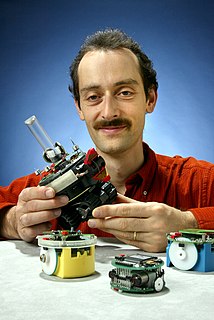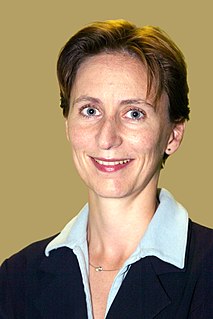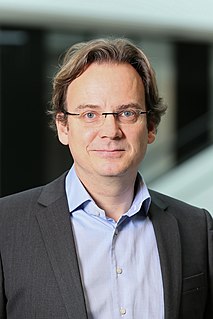The École polytechnique fédérale de Lausanne (EPFL) is a public research university located in Lausanne, Switzerland. It specializes in natural sciences and engineering. It is one of the two Swiss Federal Institutes of Technology, with three main missions: education, research and innovation. The QS World University Rankings ranked EPFL as the 14th best university in the world across all fields in 2021, whereas THE World University Rankings ranked EPFL as the world's 19th best school for engineering and technology in 2020.

Lego Mindstorms is a hardware and software structure which is produced by Lego for the development of programmable robots based on Lego building blocks. Each version of the system includes a computer Lego brick that controls the system, a set of modular sensors and motors, and Lego parts from the Technic line to create the mechanical systems.
BEAM robotics is a style of robotics that primarily uses simple analogue circuits, such as comparators, instead of a microprocessor in order to produce an unusually simple design. While not as flexible as microprocessor based robotics, BEAM robotics can be robust and efficient in performing the task for which it was designed.
Educational software is a term used for any computer software which is made for an educational purpose. It encompasses different ranges from language learning software to classroom management software to reference software. The purpose of all this software is to make some part of education more effective and efficient.

Francesco Mondada is a Swiss professor in artificial intelligence and robotics. He got a Master's degree in Microengineering at the EPFL in 1991 and a Ph.D. degree in 1997. He is one of the creators of the Khepera and directed the design of the S-bot, the e-puck, the marXbot and the Thymio mobile robots. Together, these robots are mentioned in more than 9000 research articles. In particular the Khepera robot is a milestone in the field of bio-inspired and evolutionary robotics.

The RepRap project started in England in 2005 as a University of Bath initiative to develop a low-cost 3D printer that can print most of its own components, but it is now made up of hundreds of collaborators worldwide. RepRap is short for replicatingrapid prototyper.

Webots is a free and open-source 3D robot simulator used in industry, education and research.
Lego Education is a Lego theme designed specifically for schools that concentrates sets that can be used by education institutions and includes sets the focus on Duplo and Technic themes and contain larger amounts of pieces. The theme was first introduced in 1999.
The IEEE Nanotechnology Council, also known as IEEE NTC, is one of seven councils of the Institute of Electrical and Electronics Engineers.
The Institute of Robotics and Intelligent Systems (IRIS) is part of the ETH Zurich, Switzerland. It replaced the existing Institute of Robotics, of the ETH Zurich in October 2002, when Prof. Bradley J. Nelson moved from the University of Minnesota, United States, to ETH Zurich and succeeded the Prof. Dr. Gerhard Schweitzer.

Engineering for Change (E4C) is an online platform and international community of engineers, scientists, non-governmental organizations, local community advocates and other innovators working to solve global development problems. The organization's founding partners are the American Society of Mechanical Engineers, the Institute of Electrical and Electronics Engineers, and Engineers Without Borders USA. It is now under the umbrella of ASME's Engineering for Global Development program. Collaborators include Siemens Stiftung, The Level Market, Autodesk Foundation, Global Alliance for Clean Cookstoves, CAWST, WFEO, ITU, Institute of Food Technologists, and United Nations Major Group for Children and Youth. E4C facilitates the development of affordable, locally appropriate and sustainable solutions to the most pressing humanitarian challenges and shares them freely online as a form of open source appropriate technology.
Nanosurf AG, headquartered in Liestal, Switzerland, is a developer, manufacturer and supplier of nano-microscopes for industrial and academic research, as well as for educational purposes. Nanosurf’s atomic force microscopes (AFM) and scanning tunneling microscopes (STM) are used for metrological surface inspections and for the visualization of structures, and material properties on the nanometer scale.
Adrian (Mihai) Ionescu is a full Professor at the Swiss Federal Institute of Technology in Lausanne (EPFL).
Educational robotics teaches the design, analysis, application and operation of robots. Robots include articulated robots, mobile robots or autonomous vehicles. Educational robotics can be taught from elementary school to graduate programs. Robotics may also be used to motivate and facilitate the instruction other, often foundational, topics such as computer programming, artificial intelligence or engineering design.

The gamification of learning is an educational approach that seeks to motivate students by using video game design and game elements in learning environments. The goal is to maximize enjoyment and engagement by capturing the interest of learners and inspiring them to continue learning. Gamification, broadly defined, is the process of defining the elements which comprise games, make those games fun, and motivate players to continue playing, then using those same elements in a non-game context to influence behavior. In other words, gamification is the introduction of game elements into a traditionally non-game situation.

littleBits is a New York City-based startup that makes an open source library of modular electronics, which snap together with small magnets for prototyping and learning. The company's goal is to democratize hardware the way software and printing have been democratized. The littleBits mission is to "put the power of electronics in the hands of everyone, and to break down complex technologies so that anyone can build, prototype, and invent." littleBits units are available in more than 70 countries and used in more than 2,000 schools. The company was named to CNN's 10 Startups to Watch for 2013.
Alcherio Martinoli is a roboticist and an associate professor at the École polytechnique fédérale de Lausanne (EPFL) in the School of Architecture, Civil and Environmental Engineering where he heads the Distributed Systems and Algorithms Laboratory.

Aude G. Billard is a Swiss physicist in the fields of machine learning and human-robot interactions. As a full professor at the School of Engineering at Swiss Federal Institute of Technology in Lausanne (EPFL), Billard’s research focuses on applying machine learning to support robot learning through human guidance. Billard’s work on human-robot interactions has been recognized numerous times by the Institute of Electrical and Electronics Engineers (IEEE) and she holds currently holds a leadership position on the executive committee of the IEEE Robotics and Automation Society (RAS) as the vice president of publication activities.
Video games in Switzerland have been released since the 1980s. In 2016, there were between 100 and 120 game companies, mostly small, corresponding to about 500 employees and a turnover of about 50 millions Swiss francs.

Auke Jan Ijspeert is a Swiss-Dutch roboticist and neuroscientist. He is a professor of biorobotics in the Institute of Bioengineering at EPFL, École Polytechnique Fédérale de Lausanne, and the head of the Biorobotics Laboratory at the School of Engineering.









